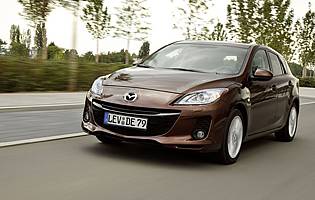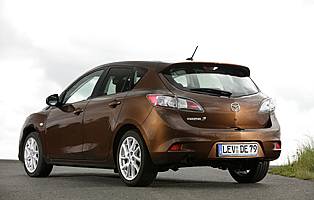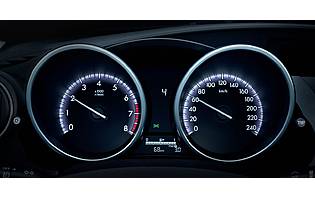



Overall rating
![]()
Subtle changes to the front include a reshaped grille




![]()
Mazda launched the popular Mazda 3 compact hatchback in 2009, and to keep pace with the host of rivals launched in that time the mid-sized offering has undergone a number of detailed changes. Of the greatest importance are the changes designed to increase efficiency, reducing fuel consumption and emissions with a subsequent improvement in running costs.
A new version of the Mazda 3 hatchback was introduced in 2009 with a view to taking on the Ford Focus, Vauxhall Astra and other UK compact hatchback market stalwarts at their own game. A cutting edge chassis shared with one of its closest rivals gave it plenty to work with, as did contemporary styling and generous standard equipment provision across the range.
All of those rivals have either been replaced or revised since then, and so it is the Mazda's turn to go under the surgeon's knife to maintain its competitiveness in this fiercely-fought sector. Most aspects of the car have undergone some changes though this is a modest facelift rather than a complete overhaul.
The visual changes are limited to a resculpted front end, where the broad smile of the grille has been gently squared-off to give more visual toughness. The fog lights have also been recessed although this has aerodynamic benefits too, while at the rear the redesigned bumper is now body-coloured in its entirety. There are also smart new alloy wheel designs to choose from.
More significantly there are a raft of mechanical alterations with the aim of improving the driving experience and increasing efficiency. The aerodynamics have been significantly honed, sufficiently so to cut the CO2 emissions by as much as 3.5% on some models - there are now five models in the range with emissions of only 115g/km.
Anyone with their eye on a Mazda 3 will be pleased with the improvements on offer, as it now costs less to run and the driving experience is slightly improved. It still stands comparison with its key rivals too, although by its own admission the Mazda 3 is a less popular choice in this segment, but on the evidence of this latest version it deserves greater success.
Overhauled with economy in mind, the Mazda 3 offers strong returns on fuel and low CO2 emissions that lessen the tax costs. The insurance costs are low and running costs should prove acceptable thanks to a strong reliability record.
Although the front is spacious and well formed, the rear is less spacious than that of some of its rivals. Regardless, only the very tall will find it short of space; the averagely proportioned will have ample room for a car of this size. The boot is a good size, if impeded by a short boot door, and door bins and cubby holes are generous.
The tunnel effect for the instrument binnacle means the dials and warning lights are always clear and free from glare. A small trip computer is ideally positioned under the windscreen. A high gear lever and fully adjustable steering wheel make for a very comfortable driving position and the ventilation controls are extremely simple to operate. Switchgear feels sturdy and is traditionally laid out.
With a good level of refinement in terms of wind, road and engine noise the Mazda 3 is unquestionably a comfortable car. The seats are supportive too, and the generous windows allow plenty of light into the cabin. The ride quality also strikes a good balance, with only the worst bumps being felt in the cabin without compromising handling or grip.
Standard equipment includes a Thatcham category one alarm and immobiliser, which ought to keep the vehicle protected. A parcel shelf obscures items in the boot from view and, of course, remote central locking is standard.
Designed to include ""crush zones"" that deform to protect occupants in an accident, the Mazda 3 features a high level of passive safety. Add to that ABS with EBD, and traction control with DSC, self-leveling bi-xenon headlamps and hazard lights that respond to emergency braking, and the model looks well catered for in the safety stakes.
There was very little wrong with the Mazda 3 driving experience in the outgoing model, but the firm has revised the damper settings and retuned the operation of the electro-hydraulic power steering system for better feel. It is difficult to notice any dramatic improvements in these respects but the 3 steers very sweetly, responding in a measured fashion to driver inputs. The suspension is also very composed, shrugging off poor surfaces and allowing the car to grip well and resist body roll when pressed. It is sufficiently smooth and undemanding to be an easy steer for the everyday drive but also engaging at higher speeds.
Room for five, improved economy and a respectable safety record combine to make the Mazda 3 a very sensible family choice. Running costs will prove appealing and there's adequate space for a trio of pre-teens in the rear.
The improved economy and restrained performance combined with stylish looks mean the Mazda 3 may well appeal to new and young drivers. It may be priced a little out of the reach of compact hatchback budgets despite Mazda's value for money, but there's little reason why it would not make a sensible first car choice if affordable.
Mazda has benefitted greatly in recent years from major improvements in exterior and interior design and the Japanese manufacturer's range is now as easy on the eye as any of its immediate competitors and many of its more premium rivals. Build quality has long been a strong point for Mazda models, and material quality is improved, too. This is noticeable inside and outside the Mazda 3 model.
The only issues with accessibility are at the rear, where a high lip and rounded entry to the boot could make lifting in heavy suitcases a less simple task. The five-door's rear doors are also slightly awkwardly shaped and offer a narrow entry to the rear of the car with a sloping roofline that may impede the tall. Access to the front remains unhindered.
A neatly integrated sound system occupies the upper portion of the centre console and is reasonably simple to operate using a combination of three large dials and a selection of switches. Where sat-nav is present it now has a larger screen which is easier to read and better integrated than before. Further audio controls are also present on the wheel. Sound quality from the system is good, auxiliary inputs are present and the TS2 model gets a six-CD changer.
The Mazda 3 remains available in an enticing palette of bold colour choices that highlight the contemporary exterior design. Lighter shades work well in flat and metallic finishes. The interior is slightly less inspiring, with dark plastics in the main, but these are broken up using metal effect trim. Soft touch plastics improve the interior ambience and cloth seating is of good quality.
Rear parking sensors are not standard until you reach the top trim level, so it's fortunate that the Mazda 3 proves an easy car to park without them. The small rear window still gives a good indication of where the car ends and large mirrors also aid reversing. The rear three-quarter design is a little messy with a small triangular window offering little in the way of visibility, but it fails to hamper decent all round visibility.
Steel spare wheel fitted as standard.
Petrol engine options - 1.6-litre (103bhp); 2.0-litre (148bhp); 2.3-litre (256bhp). Diesel engine options - 1.6-litre (113bhp); 2.2-litre (147bhp); 2.2-litre (182bhp). Transmission options: five-speed manual gearbox, six-speed manual gearbox, five-speed automatic gearbox. Trim levels: S, TS, TS2, TS2 Nav, Sport, Sport Nav, MPS.
Ford Focus Sharper to drive and to look at
Vauxhall Astra Stylish and economical but higher purchase price
Toyota Auris 1.4-litre diesel engine is less powerful, hybrid offers lowest emissions
Seat Leon Ecomotive is smart, affordable and economical